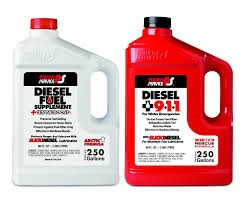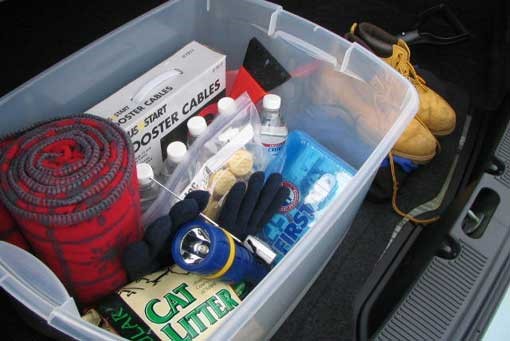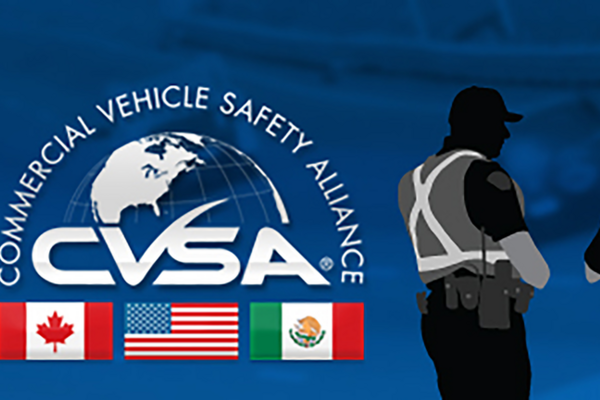Preparing For The Cold Weather Ahead!
This week's safety bulletin goes through all the tips and tricks to prepare for the cold weather! Make sure you are signed up for future safety bulletins and download a PDF version to download and share!
In This Issue:
- Preparing for the Cold Weather
- Weather Survival Kit
- Deer Season
- CVSA Releases 2022 Roadcheck Results
Yesterday was the first day of Fall, and now is the time to start preparing your operation for the cold weather ahead. Your drivers should know what is required to keep their trucks running in winter.
Preparing for the Cold Weather
Fuel Additive Use during Cold Weather Conditions
Fuel additives to prevent jelling should be added anytime the ambient temperature is below 32. Power Service and Penray are popular manufacturers of fuel additives, and both companies have two different products available through Navistar and Idealease locations.
Power Service:

- The "Red Bottle" is Power Service 911 and is to be used ONLY when the fuel in a unit has been jelled.
- 911 is NOT to be used as a fuel additive that you would regularly put in the fuel tank to keep the fuel from jelling.
- Power Service Diesel Fuel Supplement + Cetane "White Bottle" will be added to the fuel at each fill when the ambient temperature is < 30 degrees F.
- This is the additive you should regularly use during the winter months.
Penray:
Winter Thaw Emergency Diesel Fuel Supplement
- Dissolves already gelled fuel fast and reduces clogging of fuel filters.
- Prevents ice crystal build-up in fuel lines and filters by disbursing moisture.
- Eliminates hard starting, pounding, and excessive smoking and helps improve combustion.
- 100% compatible with low sulfur fuel and fuel blends.
Winter Pow-R Plus Diesel Fuel Supplement
- ULSD compliant. Prevents gelling of diesel fuel.
- Prevents ice crystal formation.
- Reduces cold filter plug point b as much as 30ºF.
- Helps enhance cetane.
- Helps improve fuel economy.
- Utilizes HAFI® technology.
- Improves cold weather starting.
- Stabilizes and prevents corrosion.
- Helps reduce emissions.
- Helps improve lubricity
How to Make a Cold Weather Survival Kit
Everyone should carry a Winter Survival Kit in their truck. In an emergency, it could save your life. Here is what you need: 
|
Tis’ Deer Season. "Oh Deer!"

It is Deer season, and now is the time to remind drivers of the dangers of animals on the roadway. The Insurance Institute for Highway Safety estimates that 1.5 million deer-related accidents occur annually. Deer are struck in three out of four accidents involving animals. Nationally, deer collisions with vehicles annually cause some $1.1 billion in vehicle damage, kill 150 people and injure another 29,000 people.
Cattle, horses, dogs, and bears also led to fatalities in collisions. Crashes with deer are most likely to occur in late fall during deer breeding, migration, and hunting season. Accidents with deer are likely to occur on rural roads with a speed limit of 55 mph or higher speed limits, in darkness, or at dusk and dawn. In 60% of the accidents involving human fatalities with animal-vehicle collisions, the fatality was caused not by the collision with the deer, but by failure to wear a safety belt. The animal-vehicle collision is the first event and often not the deadliest. What occurs to the vehicle after the initial collision is often the cause of the fatality, i.e. striking a fixed object or another vehicle(s). There is no feasible way to keep deer and other animals off the roadway. Deer whistles have been sold over the years to avoid deer collisions. I can personally attest that the whistles work. However, it is still up to the deer what action is taken after hearing the whistle. This may include standing still in the roadway or running directly at you; therefore, drivers must always be vigilant, especially in areas prone to animal crossing.
CVSA Releases 2022 Roadcheck Results
The Commercial Vehicle Safety Alliance has released the results of its 2022 Roadcheck commercial motor vehicle inspection and safety enforcement initiative. State and provincial inspectors conducted 59,026 inspections and placed 12,456 commercial vehicles and 3,714 commercial vehicle drivers out of service.
According to CVSA, a commercial motor vehicle is placed out of service when an inspector finds critical vehicle inspection item out-of-service violations outlined in CVSA’s North American Standard Out-of-Service Criteria during a roadside inspection. Being placed out of service means the driver or vehicle is prohibited from operation for a specified period or until the violation is corrected.
This year, inspectors in Canada and the U.S. conducted 36,555 Level I Inspections, and inspectors in Mexico conducted 1,150 Level V Inspections, for a combined total of 37,705 Level I and V Inspections. They placed 8,718 vehicles out of service, which is a 23.1% vehicle out-of-service rate for North America. Out of the 48,966 Level, I and II Inspections conducted in Canada and the U.S., 11,181 vehicles were placed out of service, which is a 22.8% vehicle out-of-service rate, and 3,118 drivers were placed out of service, which is a 6.4% driver out-of-service rate.
That also means that 77.2% of the vehicles and 93.6% of the drivers inspected did not have out-of-service violations. After a Level, I or V Inspection, vehicles with no critical vehicle inspection item violations are eligible to receive a CVSA decal. The CVSA decal, valid for up to three consecutive months after the inspection, is a visual indicator that signals to inspectors that the vehicle has “passed inspection.”
The top five vehicle out-of-service violations were brake systems, tires, defective service brakes, lights, and cargo securement. The top five driver out-of-service violations were false logs, wrong class license, hours of service, suspended license, and no medical card.
h an HME may not automatically receive a TWIC without going through the application process.
Idealease Will Present a Limited Number of Safety Seminars this Fall
Idealease and the National Private Truck Council NPTC will again be hosting a limited number of safety seminars in the fall of 2022. The one-day seminar this year will focus on new safety technologies available on trucks today, basic safety and compliance, regulation changes, load securement and CSA. The seminars and will be provided to all Idealease customers, potential customers and NPTC members at no charge. The seminar provides important information applicable for both the novice and experienced transportation professionals. Watch this list in future bulletins as additional seminars may be added.
To register for an upcoming seminar in the fall of 2022 click on the following link:
https://www.idealease.com/safety-seminars
Sep 21 | |
Oct 11 | |
Oct 13 | |
Oct 18 | |
Oct 25 |
*The Idealease Safety Bulletin is provided for Idealease locations and their customers and is not to be construed as a complete or exhaustive source of compliance or safety information. The Idealease Safety Bulletin is advisory in nature and does not warrant, guarantee, or otherwise certify compliance with laws, regulations, requirements, or guidelines of any local, state, or Federal agency and/or governing body, or industry standards.

